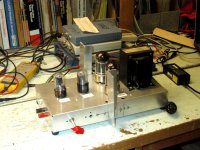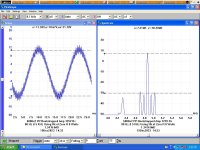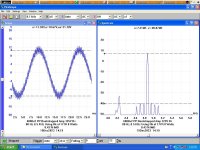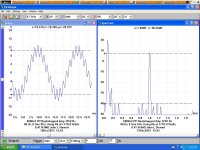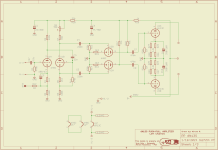A while back I installed cathode resisters that are heat sinked to the Aluminum chassis,
I've more recently installed two pieces of extruded aluminum to better dissipate the heat.
And here are some recent IMD measurements taken at a lower B+.
All the conditions are listed on the scope screens,
Like all my amps over the last 25 yrs, this amp is strictly experimental for me, not to listen too or a thing of beauty.
I've more recently installed two pieces of extruded aluminum to better dissipate the heat.
And here are some recent IMD measurements taken at a lower B+.
All the conditions are listed on the scope screens,
Like all my amps over the last 25 yrs, this amp is strictly experimental for me, not to listen too or a thing of beauty.
Attachments
HV is regulated 380Vdc. Pout before clipping is about 11.5Wrms with approx. 0.8% THD+N. Bandwidth 20Hz - 20kHz +/-0.2dB at 1Wrms. For the measurements I have used QUANTASYLUM QA402.
If there is something to complain about, it is that H3 is quite close to H2 percentage. In the meantime I have built another amp based on the same schematic, with very similar results.
If there is something to complain about, it is that H3 is quite close to H2 percentage. In the meantime I have built another amp based on the same schematic, with very similar results.
The Quantasylum looks like a very useful piece of test equipment. A great way to get a lot of performance data from your amplifier.For the measurements I have used QUANTASYLUM QA402.
I've been using a Picoscope 3224 for about 15-20 years. It is 2-cahannel, 10 MHz each channel.
The amplitude resolution is 12 bit, 72 db in a perfect World,. Enough for most tube amp applications.
Both Frequency & Time Domain results are continuous displayed on the laptop, in this case running XP.
For the frequency domain measurements several curve fitting choices are possible. Most of the time I use a Blackman window. 👍
For the IMD tests I still use an HP200CD wide range audio oscillator I bought in an auction about 25 years ago,
The other is a SS GW GAG810 Audio Oscillator. The two audio signals mixed in a simple resistive network so they don't interfere with each other.
